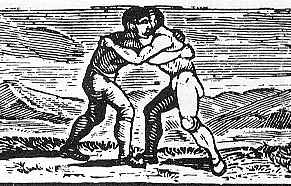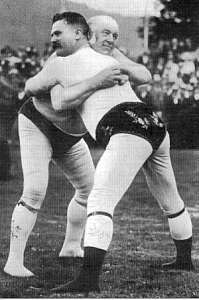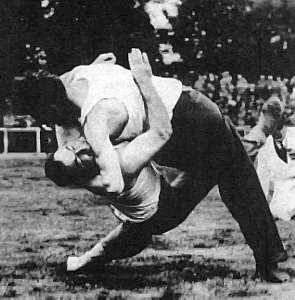
By Roger Robson
From Cumberland and Westmorland Wrestling: A Documentary History
by Roger Robson
(Carlisle: Bookcase, 1999), ISBN 0951992106. To order, write . Copyright Roger Robson 1999. Reprinted courtesy Roger Robson. All rights reserved.

Engraving from the school of Thomas Bewick (1752-1828). As the book from which this engraving was taken was not published until 1870, it is not possible to date the engraving precisely, but it is essentially eighteenth century.
Before 1860 Cumberland and Westmorland wrestlers simply stripped off to their shirts, breeches and stockings before competing. The neat fit of the garments made them ideal for wrestling as they did not impede trips such as the hank [EN1] and the outside stroke [EN2], and they would not obscure falls for the judges.

The Grand Match, Carlisle Races, 1813. The two men are not wrestlers, but Scottish politicians whose blue and yellow ribbons denote their parties.
Stripping off was sometimes a reluctant affair as the following passage from Robinson and Gilpin's book Wrestling and Wrestlers (pub. 1893) recalls:
About the year 1820 on New Years Day, the ground was covered with a coating of snow three or four inches deep. It so happened that Isaac Mason of Croglin was drawn against Isaac Westmorland of Ousby. Mason - well known for his smuggling adventures and his numerous eccentricities - entered the ring wearing an old home-spun overcoat, so thick and patched that it set at nought all Westmorland's attempts to clasp his arms about it. No persuasion could induce Mason to try and accommodate matters by stripping. He would not move a jot and in the meantime his opponent was becoming quite numb and frigid with cold. At length Mason showed signs of relenting and ultimately took off the obnoxious overcoat. Still Westmorland's arms were found to be too short and refused to meet. Continuing then to 'doff' what was most cumbersome - off went the coat, then the waistcoat, and finally Mason stood stripped to his 'sark' [shirt] in the snow, with nothing on but his trousers, where his opponent managed to keep him standing until he, in his turn, was nearly starved to death.
The standard wrestling strip for the first half of the nineteenth century remained the sark and trousers so reluctantly revealed by Isaac Mason. A Railway advertisement for a "Cheap Train" from Newcastle to Haydon Bridge for the match between Iveson and Jameson in 1845 has one of the clearest and most detailed views of the accepted strip, and also shows the wrestlers in action for the first time.
From the frontispiece of Wrestliana; or, an Historical Acount of Ancient and Modern Wrestling, by W. Litt, 1823.
Even as late as 1858 the strip remained constant. Charles Dickens in his lively account of the wrestling at "the Ferry Ring on Windermere" describes the appearance of the wrestlers: "They strip to their drawers and flannel waistcoats, exhibiting such studies for the painter and sculptor as are rarely seen elsewhere." (Household Words, Feb. 6, 1858.)
By 1862, change was in the air. The great champion Dick Wright of Longtown still favoured the old style of shirt and knee breeches, but others were wearing the newest of athletic fashions, white tights and shirt, and an ornate centrepiece.
An article in the Pall Mall Gazette from 1867 admitted: "that considered from an aesthetic point of view, wrestling is a very pretty sight. The men are dressed in tightly fitting garments of an acrobatic or pedestrian appearance, and some of them were splendid specimens of muscular development."

Taking hold, 1879. The kneeling referee holds a sand-clock (this was before stopwatches were common) to determine the time allowed to take hold, while the standing judge holds the flags used to show the crowd which wrestler was the winner.
The most detailed account of all about the new fashion comes from the Carlisle Journal, July 8, 1870, in its coverage of the annual athletic sports of the Cumberland and Westmorland Wrestling Society held in a large wooden enclosure erected in the usual position on the Swifts, Carlisle:
The variety and picturesqueness of costume which has of late become an indispensable feature in the wrestling arena, was also largely displayed. Some indeed, either from a proud contempt of outward show, a want of taste, or some other influence equally potent with them, deviated from the conventional rule, and competed in the vest and trousers of everyday corduroy or "hodden grey"; but these cases were few, and the majority conformed to the established custom many of them indeed, carrying their selections of partial coloured fleshings to a somewhat extravagant extent, and appearing in attire strongly resembling that of mountebanks.
For the past one hundred and thirty-five years, the accepted "traditional costume" for Cumberland and Westmorland wrestling has remained basically the same. The details have changed at times: suspenders came and went, granddad vests changed to singlets, for a time flat caps were worn in the ring, neat swimming trunks are still an acceptable alternative to the velvet centrepiece, shorts, particularly, Bermuda shorts, were banned recently as a variation of the centrepiece.

George Steadham (left) takes hold of Hexham Clarke, August 1900. It was the 54-year-old champion's last appearance at Grasmere.
The present rules on the traditional wrestling costume state that:
The strip consists of four parts:The strip can be of any colour, and of any suitable material. Torn and muddy strips are unacceptable, unless the damage has occurred on the same day.
- A pair of socks
- Leggings which fit tightly to the leg (such as long-johns or tights)
- A centrepiece elasticised round the waist and legs. In the absence of a purpose-made garment, a bathing costume is acceptable. (Please note that shorts are not acceptable as a substitute.)
- A singlet vest or tee-shirt.
The modern rule defines a fashionable quirk of Victorian athletic costume which lasted twenty years or so in athletics, but remains today as the distinctive wrestling strip which is a central part of the wholesome image of our Northern sport.

Tommy Little throwing Ted Dunglinson, August 1948. The baggy trousers were allowed because of post-war clothes rationing.
EN1. The hank is where a wrestler twines a leg round an opponent's leg and then straightens it to pull him to the ground.
EN2. An outside stroke spins a man onto a tripping foot.